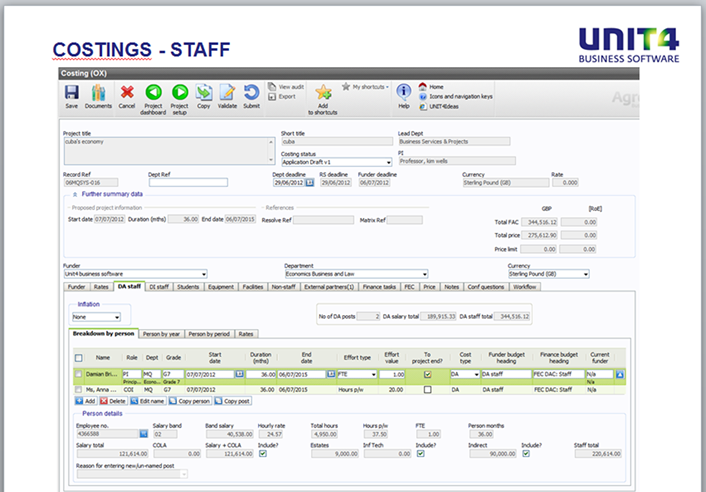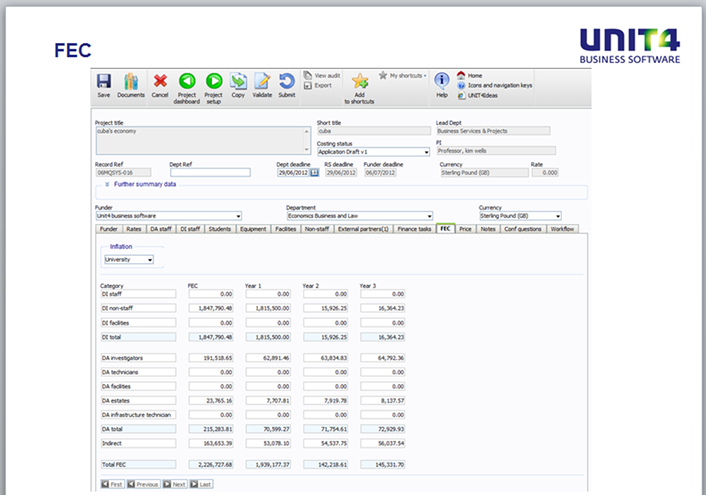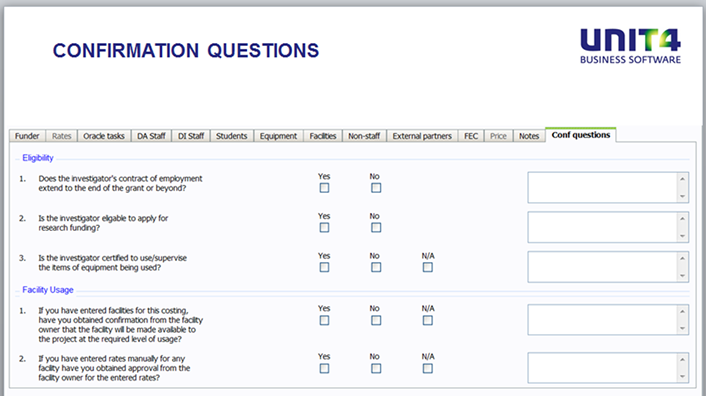Paul Dampier is MIS director at the University of Cambridge, and Glenn Swafford is director of Research Services at the University of Oxford.
Together, we recently developed from scratch a brand-new technology solution to manage our research costing and pricing, which we subsequently rolled out to both our campuses, the University of Cambridge and the University of Oxford. That might sound a bit dry, but it has helped us address considerable market and strategic challenges. Our chosen technology, UNIT4's Agresso Research Costing and Pricing, in itself will not change the world — it's an administrative solution, after all — but it is freeing up the time of our highly skilled staff, who sometimes can.
Figure 1 shows a sample screen from the program.

Figure 1. Sample Staff Costings screen
Challenges in the Research Sector
The research sector faces a unique combination of circumstances that have whipped up the administrative equivalent of a perfect storm. This is especially true for research-led higher education institutions looking to do business in the UK. Three years ago we confronted external market and compliance challenges that exerted considerable pressure on our research systems and the projects they administered. The governance regime in the UK was becoming increasingly complex, with research institutions required to accurately establish the full economic costing (fEC) and price of each project and comply with TRAC (Transparent Approach to Costing), a standard methodology used by the 165 higher education institutions in the UK for costing their main activities. Furthermore, research providers have to alter the cost and price of projects based on individual funders' requirements.
The importance of research to both our institutions cannot be underestimated, but its management is a complex beast. The University of Cambridge has over 1,000 researchers making grant applications each year, and the University of Oxford often needs to pull in data from multiple cost centers for a single project. This gives you an idea of the considerable complexity we face when it comes to complying with TRAC and funders' procedures.
At any time either university could be subject to an external audit by our funders on any area of our costing and pricing regime, from our systems to staff training. If we cannot present the required data, it is at best embarrassing and at worst will incur financial penalties and strike a blow to our hard-earned reputations.
Regulations aside, the bigger picture was further complicated by market forces; both universities were facing greater competition from international institutions and also from domestic entrants to the market. Those organizations were seeking to boost their coffers with research revenue as the UK's university funding model changed.
With all the changes in the market, we had to adapt our strategy to try and stay ahead. For instance, both universities sought to increase collaborations with multiple research organizations on larger projects. However, such changes in strategy, compounded by multifaceted reporting, would be a tremendous burden on the existing research management systems used by both our Institutions.
We're similar organizations with similar IT functions that faced the same issues at the same time, so it was logical for us to collaborate on a project to address the situation.
Finding a Solution
At the start of this journey our first move was to employ technology research firm Gartner to review our functional requirements and consider the best approach. Our experiences of the situation were borne out when Gartner concluded that any solution would be highly complex, requiring the same amount of development that a small banking organization would require for an in-house system. With this in mind they recommended that the universities partner with a specialist software organization to develop a solution.
We sounded out Microsoft, Oracle, and UNIT4 to partner with us. Microsoft and Oracle would build the solution but not provide ongoing support. The model with UNIT4 was different: We would work together on the solution, and then when it was finalized, they would have the rights to offer it to the wider market. For everyone this was the sensible option — at the end of the project UNIT4 would have a solution that they could sell, and because of that we would have a technology partner that was 100 percent committed to producing a world-class answer to our problems.
We also chose UNIT4 because it already had an existing higher education–specific technology platform founded on its Agresso framework, which is used in hundreds of institutions around the world for back-office transactions like finance, HR, and payroll. This sector expertise was very important to us, and we could really see the merit in being able to integrate research into the "back office."
The three organizations spent 15 months developing and honing Agresso Research Costing and Pricing using the PRINCE2 project management methodology. With three of us, often with different objectives, we sometimes encountered challenges in agreeing on the solution roadmap. To assist with this, a project board was formed to oversee the project, where senior sponsors could evaluate progress and make quick decisions to create a product that would benefit the wider sector. UK R&D Director David Harwood was the UNIT4 executive sponsor. He significantly assisted with the success of the project by overseeing key development within UNIT4.
Implementing the Solution
On time and on budget we created an fEC (figure 2), pricing (figure 3), and approval tool (figure 4) that enables the production of accurate cost estimations and agreement on appropriate prices for grant applications and research contracts. With our respective research organizations using a different operating model, however, our implementation needs were quite different. Because the Agresso infrastructure is highly flexible (which was another attraction), we could change the solution to meet our needs. The implementation process at each university involved stakeholder workshops to establish our individual ways of working so that the solution could be configured appropriately.

Figure 2. Sample fEC screen

Figure 3. Sample Price screen Costings

Figure 4. Confirmation questions
Some principal investigators, research administrators, and academics may only come into contact with Agresso every two years. However, we have found that the intuitive nature of the solution is helping them avoid hours of training and, as users, hit the ground running (figures 5 and 6). The solution is also integrated into relevant systems, like the universities' finance application (although this is pending at Oxford), to automatically push and pull data, significantly reducing the amount of time spent hunting for it using a manual system.

Figure 5. Project setup wizard screen

Figure 6. Project setup screen
Using salary information, non-staff costs, facilities costs, inflation assumptions, fEC research rates, and so forth, Agresso Research Costing and Pricing enables us to accurately determine the full economic cost of research projects. Then, applying predetermined scheme templates that reflect different sponsor rules, the program can calculate the price to be charged to the selected sponsor for project activity.
The program allows us to use a consistent approach to research costing including data input, output, and interpretation, evidenced by clear audit trails through a single, shared system. It supports traditional research projects and also complex projects that may involve multiple institutions and multiple funders across the world and their different currencies. Some of the more sizeable projects also require self-funding at the start of the research. With Agresso, department heads have greater certainty of the actual finances involved, making it easier to commit to larger projects that generate greater revenue. In this respect it is a game changer for us.
Additionally the tool is making collaborations easier. By working with world leaders at other institutions, who in turn can capitalize on Cambridge and Oxford's considerable knowledge, we can put forward more powerful and convincing bids (see figure 7).

Figure 7. Sample information page
Going Forward
As we face ongoing change, whether to our own strategy or to those strategies imposed by funders, we can make some changes to the solution ourselves, without having to call on costly external consultants.
Without a research costing and pricing solution, we would not be able to make applications for grants, set up costs, or start projects; it would be like trying to fly a 747 without instruments. It also takes the stress out of audits and helps us demonstrate to funders that we meticulously plan our costing and pricing. Most importantly, the good that comes from the collaborative development of the technology is creating a virtuous chain reaction: extra revenue from larger projects can be ploughed back into our faculties and research facilities for the good of our campus community and beyond.
© 2014 Paul Dampier and Glenn Swafford. The text of this EDUCAUSE Review online article is licensed under the Creative Commons Attribution-NonCommercial 4.0 license.
